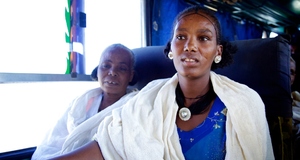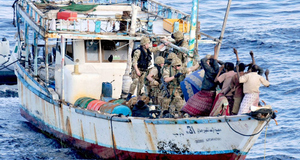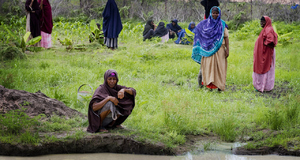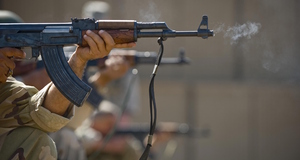Featured Article:The Horn of Africa: Critical Analysis of Conflict Management and Strategies for Success in the Horn's FutureCIVIL STRIFEInternal conflict has emerged in every nation of the Horn. In Ethiopia, resistance emerged when the Dergue, a communist military junta, came to power. Opposition groups eventually dissolved the Dergue, but the key players remained in power and conflicting political ideologies instigated the emergence of various rebel groups. In Eritrea, rebels fought for their independence against Ethiopia after the dissolution of the Eritrean parliament and revocation of its right to autonomy. However, once control of the region was wrested, Eritrean guerilla groups and fighters from the Tigre turned on each other. Conflict in Somalia surfaced when Somali dictator, Siad Barre, attempted to promote greater Somali nationalism through the dissolution of clan power. Fierce clan opposition eventually led to his overthrow and to the power vacuum that, to this day, has yet to be filled. Even Djibouti, which had abstained from much of the region’s conflict, was not immune to internal power struggles. Through the examination of these nations’ civil conflicts, a common thread can be established. It will be determined that civil turbulence in the Horn will continue until the public takes ownership of the resolution process. Only after public accountability is established, and an option created for opposition groups to meet their goals through peaceful disagreement, can progress can be made.Ethiopia: The Dergue, Mengistu, and Opposition GroupsEthiopian civil conflict emerged with the Dergue, a communist military junta that came to power following the removal and imprisonment of Emperor Haile Selassie. The monarchy was formally abolished in May 1975, and Marxism was proclaimed the ideology of the state. Up to this point, the United States was allied with Ethiopia; the declaration of Marxism as the state’s ideology created a stark divide between those subscribing to the political doctrine of either superpower. The rise of the Dergue, along with this division, brought civil war. During the years 1975-1977, called the Red Terror, the Dergue and its opposition engaged in a brutal policy of “execution, assassination, torture, and imprisonment of tens of thousands without trial.” After the Dergue destroyed its opposition, it successfully fought off an invasion from Somalia and then engaged in war against Eritrean rebels (Library of Congress 1993 DT272.E83). Guerrillas fighting for Eritrean independence took advantage of the opportunity to further frustrate Ethiopian leadership by aligning themselves with various opposition groups, such as the Tigrean Peoples’ Liberation Front (TPLF), Ethiopian Democratic Union, and the Ethiopian People's Revolutionary Party. While countering these rebels, the Dergue leadership fought one another. The struggle for power resulted in numerous appointments and removals (or executions) of various heads of the Dergue. Of the many Dergue commanders, Mengistu Haile Marian was able to retain control after being appointed Commander in Chief of the Armed Forces. He utilized his post to wrest control of the country and gained popularity by formally dissolving the Dergue. He replaced it with the People's Democratic Republic of Ethiopia (PDRE) but, despite the leadership party change and construction of a new constitution, many government positions within the Central Committee and the Politburo of the Worker's Party of Ethiopia (WPE) were filled by Dergue members. Mengistu continued his role as Commander in Chief of the Armed forces but additionally acted as President of the PDRE and Secretary General of the WPE (Library of Congress 1993 DT272.E83). He remained in power until deposed in 1991. During Mengistu’s reign, discord in Ethiopia was further aggravated by conflict in Eritrea. Conflict was created during Emperor Selassie’s reign when Ethiopia dissolved Eritrea’s parliament and negated its right to autonomy. Eritrea’s subsequent declaration of independence and revolt by various rebel groups prompted a venerable crisis between the two nations, characterized by human rights atrocities committed by both sides. Eritrea and Its Call for IndependenceEritrea demanded its independence when Emperor Selassie dissolved its parliament and created fierce opposition between the two nations. When the Dergue came to power, they imposed a military settlement on the Eritean Liberation Front and the Eritrean Peoples’ Liberation Front (EPLF). However, the Dergue’s invasion of Eritrea was unsuccessful; by 1978, Eritrean rebel groups controlled nearly all of the countryside. Despite controlling major cities, the Dergue were unable to suppress the rebellion. In addition to the Eritrean secessionists, other rebel groups remained highly active, including the TPLF, the Oromo Liberation Front, and the Somali Abo Liberation Front. These groups gained control of the countryside in southern Eritrea, while other groups remained active in the cities in an effort to frustrate Ethiopian military operations. By 1978, Eritrea was no longer under Ethiopian control. Between years 1982-1985, the EPLF and Mengistu’s regime held an unsuccessful series of talks in an effort to resolve the conflict. However, both parties were convinced that their goals would be met through victory, and both believed that they would soon be victorious. Each side remained resolute in an effort to demonstrate its commitment to its objectives; they each believed the time was ripe for winning, not for resolving. By 1987, rebel groups in “Eritrea and the Tigre controlled at least 90 percent of both regions” and in 1991, the EPLF “set up a provisional government… under Issaias Afwerki,” (ACED 2000). In 1993, a referendum resulted in 98 percent of voters favoring Eritrean independence, and the nation received its independence later that same year. Believing the conflict resolved after Eritrea won its independence, the international community expressed its relief. This relief was, however, short lived. Barely five years passed before war broke out between the two nations under a different pretense. This demonstrates the multiple dimensions of conflict, and will be further examined. Meanwhile, in neighboring Djibouti, a different type of civil conflict erupted. The civil unrest in Djibouti was the result of ethnic disgruntlement. While many African nations have experienced similar clashes, many of those conflicts occur from historic resentment of one group toward another. The hostility in Djibouti was not deep-rooted, and the government’s response to opposition demonstrated adequate local mediation procedures that allowed it to resolve its internal unrest quickly and effectively. Djibouti and FRUDDjibouti was historically nomadic, comprised of Issa Somalis and Afars. After gaining independence in 1977, Djibouti’s first election was held and resulted in Hassan Gouled Aptidon, an Issa, being elected the nation’s first president. He appointed both Issas and Afars so that his cabinet was roughly balanced, but the dominance of Issas in his administration led to political criticism. Despite this, Gouled was reelected, without opposition, in 1981 and 1987. Throughout the 1980s, Gouled faced growing dissatisfaction from the Afar population, who believed that his administration did not accurately represent Afars. The height of this criticism resulted in an uprising in 1991 by Afar guerrillas, calling themselves the Front for the Restoration of Unity and Democracy (FRUD). FRUD’s activities resulted in the deployment of French troops; after some skirmishes, a ceasefire was declared by the Afars in 1992. When fighting persisted, the government launched a successful counteroffensive that disarmed the majority of the FRUD by 1994. The conflict was further resolved through the integration of a portion of the FRUD into Djibouti military ranks, and two FRUD leaders later accepted ministerial posts. In March 1996 the FRUD was given legal recognition as a political party. Djibouti leadership provided the political space for opposition groups to disagree peacefully by assimilating them into the political landscape. The government asserted its power to control violence, but did not authoritatively forbid disagreement or react with unnecessary bloodshed to assert its dominance.Continued on Next Page » Suggested Reading from Inquiries Journal
Inquiries Journal provides undergraduate and graduate students around the world a platform for the wide dissemination of academic work over a range of core disciplines. Representing the work of students from hundreds of institutions around the globe, Inquiries Journal's large database of academic articles is completely free. Learn more | Blog | Submit Latest in International Affairs |


















